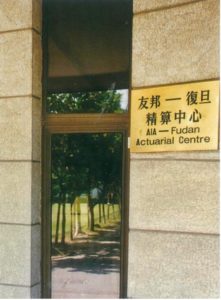Actuarial Education and Talent Cultivation in China
A discussion with Benny Zhang, FSA, chief actuary of AIA Life
June 2023In the late 1980s and early 1990s, the Society of Actuaries (SOA) achieved two important milestones for actuarial education and career development in China. In November 1987, the SOA and Nankai University signed an agreement to create an actuarial postgraduate course in China. The SOA took pioneering steps to bring the actuarial profession to the country, marking the beginning of actuarial education in China. In 1992, the SOA established an examination center in Nankai, which marked the beginning of the actuarial profession in China. That same year, AIA came to Shanghai and established actuarial centers with multiple universities. The actuarial centers have trained hundreds of actuaries in mainland China and have become the cradle of actuarial talent cultivation in China. AIA China was also known as the “Huangpu Military Academy” for insurance talent.

Over the past 30 years, the SOA and AIA have developed a cooperative, strong and communicative relationship. With a long-term perspective, international thinking, professional-level global talent and innovative services, both organizations are committed to the wide dissemination of actuarial knowledge, the diversified cultivation of actuarial talent and the high-quality development of actuarial science in China.
The SOA was pleased to interview Benny Zhang, chief actuary of AIA Life, to discuss China’s actuarial education, career development and talent cultivation path, among other topics.
How do you view the development of actuarial learning in China in the 1990s?
When AIA returned to the mainland China market in 1992, the domestic actuarial profession was still in its early stages. Everyone lacked knowledge of basic actuarial concepts, and there were few actuaries in the insurance industry. It’s worth recalling that the earliest actuarial education in China was the actuarial science program established at Nankai University. The North American actuarial qualification examination system was then introduced in cooperation with the SOA along with support from Professor Tuan Kailin in the late 1980s.
In 1993, thanks to support from Dominic Lee, the SOA established an examination center in Shanghai. The following year, AIA and Fudan University collaborated to establish the AIA-Fudan Actuarial Center in Shanghai, which held actuarial training courses. The Actuarial Center was geared toward students, providing a platform to popularize actuarial knowledge, systematically study actuarial science and prepare for actuarial qualification certification. As a result, we have attracted many excellent talents to pursue and begin careers in insurance and actuarial science.
After that, AIA began collaborating with other universities and established the AIA-Sun Yat-sen University Actuarial Center, the AIA-University of Science and Technology of China Actuarial Center, the AIA-Peking University Actuarial Center and more. These centers have produced a large number of young actuaries in mainland China. Additionally, AIA established a Chinese actuarial teacher internship base at its headquarters in Hong Kong. More than 10 university teachers have received funding to practice at AIA, thereby gaining valuable practical experience in the actuarial realm.
What impact has the SOA had on developing China’s actuarial industry?
In the 1990s, China’s actuarial education and career path started to grow, and AIA introduced the agency system in China. This led to a new stage of growth and development for China’s insurance industry and actuarial science. As an international company, AIA understands the responsibilities and roles that actuaries should assume in the daily operations of insurance companies.
However, at that time, the market’s talent stock and growth rate were insufficient to meet the industry’s developing needs. The construction of talent echelons became a key factor in overcoming this situation. The foundation of this key point lies in education. While many agree on the need to popularize actuarial education, it cannot be achieved by just one company.
As an international organization dedicated to promoting actuarial education, the SOA had a well-established professional knowledge and talent training system, as well as actuarial qualification certification. For China, which lacked an actuarial examination system and had not yet fully established an actuarial association at that time, learning from the SOA education model greatly enhanced the development of actuaries and talent echelons in China.
Since the SOA entered China, it has cooperated with multiple universities and established examination centers in more than 10 cities to help candidates prepare for exams more effectively. Meanwhile, AIA is actively assisting universities in applying for examination sites, leveraging the advantages of enterprises and providing students with more economical and resourceful opportunities. In general, the SOA and AIA are striving for a common goal: cultivating local actuarial talent and contributing to the long-term development of China’s actuarial and insurance industries.
Please describe AIA’s project work with universities and the original purpose of the AIA-Fudan Actuarial Center.

When AIA and Fudan established the Actuarial Center to provide more resources to students and society, they also facilitated the development of China’s actuarial and insurance industries. As the insurance industry was just opening up and about to embark on a fast track of development, the role of actuarial science in the long-term operation of insurance was becoming increasingly apparent. This also meant that we needed more actuarial talent with an international perspective.
In the 1990s, people’s living standards were not high, and the degree of openness was limited. It wasn’t easy to become an actuary. For instance, registration fees were expensive, textbooks were scarce and only the original version of the books in English was available. This made it difficult for Chinese families to bear the cost, and even if students were willing to study actuarial science, they might eventually give up due to the lack of learning resources and limited economic conditions.
At the AIA-Fudan Actuarial Center, we provide students with textbooks and offer free SOA assessment courses to help students better understand actuarial knowledge. We also have set up scholarships to refund exam fees for candidates who pass the exam, thus reducing the burden on many. Moreover, our cooperation with major universities has benefited students from these schools and attracted students from nearby universities who are interested in actuarial science. As a result, the AIA-Fudan Actuarial Center has produced many outstanding talents for the entire market and industry. Many prominent individuals in the actuarial field in China have benefited from the cooperation of the various university actuarial centers.
My professional understanding of actuaries began with the Actuarial Center. It was also the source of my initial exploration of actuarial knowledge. In addition, the center provided me with the resources and funds to complete the actuarial exams, and its support helped me persevere in my actuarial science studies.
What are your thoughts on the multiple economic cycles and challenges society has faced over the past 30 years?
I believe that both insurance management and actuarial work need to maintain a long-term perspective, which is also the core of AIA’s commitment. Society constantly changes, and new things and phenomena will continue to emerge. Therefore, companies and actuaries will always face short-term disturbances and bear great pressure and challenges. The more intense the moment, the more critical it is to maintain a long-term perspective on the entire experience, philosophy and corporate strategy and persist in doing the right things for the long term. This is not to say that we should ignore short-term issues but rather consider long-term issues more deeply. For example, during financial crises, we need to consider the financial situation, actuarial practices, management level and business philosophy of the enterprise itself; look at long-term development strategies; take a long-term perspective on China’s actuarial development; and seek sustainable value.
Many actuarial concepts are viewed from a long-term perspective. Therefore, if a life insurance company lacks long-term support from actuarial concepts, its development will deviate from the intended path. This brings us to the importance of cultivating actuaries. When discussing the role of the SOA in actuarial education, we not only focus on student exams but also consider the entire career. This is a topic that the SOA and AIA are discussing—strengthening actuarial education and professional ethics. As actuaries, we have a professional ethics training mechanism that constantly reinforces our integrity and initial aspirations for our profession. Amid industry transformation and development, actuaries must maintain professional ethics and standards and adhere to long-term principles.
Using your years of actuarial experience, what are your plans for cultivating future actuarial talent?
Given the promising prospects for actuarial development and the recognition of actuaries as valuable professionals, providing platforms and channels to attract outstanding talent should be sufficient. In the past, we worked to build platforms and broaden channels to support candidates in passing exams and receiving career training, which helped create a pool of outstanding talent.
The financial sector has diversified as the economy has developed, and talent development has become more diverse as well. There has been a greater understanding of insurance and actuarial science in China, and more voices from different industries have emerged. Additionally, in the current situation, fresh blood is needed to join the team if actuaries want to manage actuarial business and lay a strong foundation for talent development. The challenge we face now is how to leverage the role of the SOA and provide a platform for actuaries to attract new talent to the insurance and actuarial fields.
Over the past 30 years and into the next 30, AIA has persisted in actively exploring suitable talent construction models for future development. This is consistent with our long-term philosophy of supporting and empowering all those who aspire to engage in actuarial work. AIA has always taken the time to do this “slow” work. It’s not just about teaching technical skills; the key is to impart the right concepts.
What are the qualities of a good actuary?
A good actuary should be able to think and plan for the long term. This quality is also reflected in their approach to learning. In a rapidly changing and competitive environment, self-learning is crucial. It is important to cultivate the habit of continuous learning throughout one’s career. When I was studying to become an actuary, there were many materials to cover for the exams, and even with teachers to explain them, the explanation was limited. This greatly tested my ability to learn and master new things, as well as my ability to judge social changes. However, this is a good quality that I cultivated through my actuarial studies.
With society changing at an even faster pace today, it is even more important for actuaries to transform their judgment in learning into influence that they can exert in their positions after accumulating certain experiences.
In fact, the motivation behind all behaviors is to adhere to professional ethics. This is why organizations emphasize vocational education and provide professional ethics training every year. Such training can help us adhere to the standards we should uphold in the actuarial profession.
AIA and the SOA have always maintained close ties. What expectations do you, or AIA, have for further cooperation between the two parties?
I anticipate that AIA and the SOA will keep up with the times, further explore better cooperation models and leverage the synergy of companies and associations to promote actuarial development. This exploration process is of great significance to us.
Do you have anything you want to say to Chinese actuarial talent?
I hope that all actuarial talent can remember three things:
- Rely on your own learning ability
- Maintain the discipline of the actuarial profession
- Fully exert your influence
In this era of change, actuarial science is also evolving and developing. The SOA and AIA are determined to face the challenges and opportunities of this new era. To learn through thought, understand through reflection and act with understanding. To adhere to long-term principles, continue cultivating local talent, promote the high-quality development of actuarial science and create a “golden” future together.
Statements of fact and opinions expressed herein are those of the individual authors and are not necessarily those of the Society of Actuaries or the respective authors’ employers.
Copyright © 2023 by the Society of Actuaries, Chicago, Illinois.

